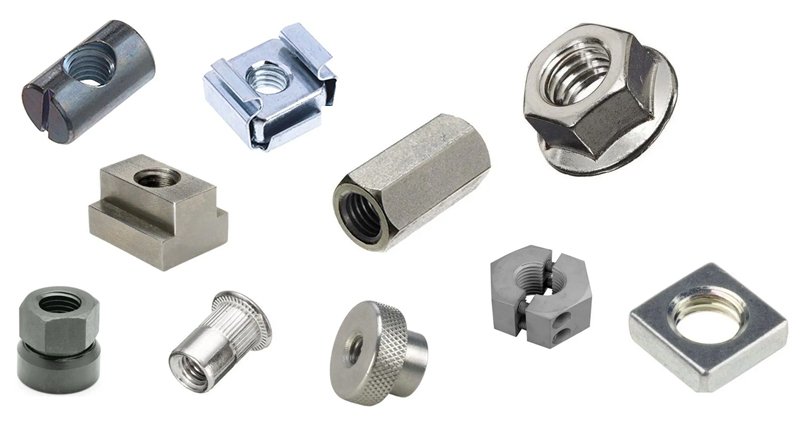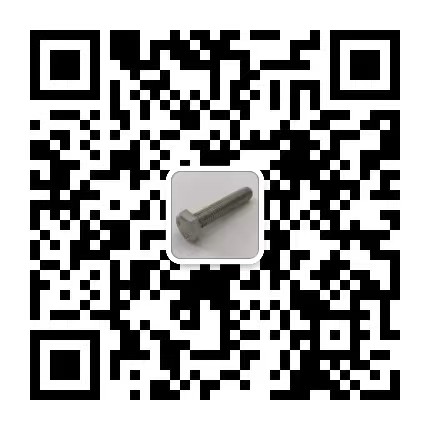VIDEO & CENTER

13 different types of mechanical nuts and their uses
The nuts are mostly hexagonal, followed by squares.
Different types of nuts
- Cap nut
There are two types of cap nuts. One is a low, or standard cap nut. The other is a tall cap nut. Higher cap nuts are wider and taller to protect extra long studs. There are also self-locking cap nuts with twisted threads in the hexagonal area to form a tight friction fit to prevent the nut from loosening due to vibration.
Barrel nut
2, the barrel nut is also known as the screw nut or screw nut, it is composed of steel material, known as a special nut, very often used in aerospace, has also been found to meet the purpose of furniture.
These types of nuts mainly have very thin bolt sheets and metal parts, as well as commonly used billet or forged parts. Barrel nuts are preferred over standard nuts and bolts because they do not require flanges to be machined or forged on receiving parts. This will reduce their weight.
3, furniture cross dowel bucket nut
Furniture cross pin bucket nut, which is designed to resemble the shape of a cylinder, is specially used for bolts in furniture as a connector to join two pieces of wood. The threaded hole inside the nut is the most versatile, and it goes through both sides of the board.
In the installation process, the two pieces of wood need to be aligned and connected, and then the bolt hole is drilled through one piece of wood and into the other piece of wood. Barrel nuts are also common in flat-pack furniture, and both long bolts and barrel nuts are used to secure T-joints.
- Cage nut
Cage nuts are also very commonly known as captive or clip nuts, which consist of a square nut in a spring steel cage that wraps around the nut. Whenever loose is found, they are responsible for securing the nut in a specific position behind the hole. Cage nuts were introduced in 1952 and 1953. The cage nut is designed so that a tool needs to be inserted to fit the cage nut into the hole. Newer designs also feature squeeze and release capabilities for toolless installation.
Square hole cage nuts are technically referred to as those nuts that can be easily used in all those places where square holes are found, drilled according to their needs. This is an old captive nut that uses a spring clamp that usually holds the nut in place and slides over the edge of the sheet.
The nut's application is usually in a slightly looser cage, allowing for minor adjustments in its alignment. This is responsible for reducing the possibility of the threads being peeled during installation and removal of the equipment. The dimensions of the spring steel clamp are responsible for determining the thickness of the panel on which the nut is clamped. In this case, the size of the clip is mainly determined by the distance between the edge of the panel and the hole.
- Clamp nut
Clamp nut refers to a type of nut also known as a metal plate nut or a quick nut. A clamp nut is a specially designed nut that can be clamped onto a metal plate. These are the most common types of captive nuts consisting of cage nuts.
Types of clamp-nuts: Clamp-nuts are the most common type, which come in many forms based on: where they are clamped, shape and thread type. Each clamp nut is designed to work perfectly, even for a small range of sheet metal gauges. It is worth noting that these types of clamps are constructed of spring steel.
- a) G-nut
- b) J-nut
J-nuts are nuts that are found clamped to the edge of a metal plate. This type of nut is named in such a way because its shape is a letter J, where the thread is found on the longer side of the "J ". The short fixed legs did not allow for more floating, which was thought to be the cause of the misalignment, while the nuts were found to be free to unclip the metal plate.
- c) Square nuts
The square clip nut means that although it has a square hole or groove on the edge, it is not suitable for clamping on the edge of the metal plate. Also known as a square nut, it has a metal plate retainer that protrudes on either side of the nut. These feet form a "lip" that usually holds a metal sheet object. Before the nut is tightened, you will be able to observe it floating in the hole or slot, and only when the nut is found to be fully tightened will it press down on the lip outside the reholder, thereby holding itself in the desired position.
- d) U-shaped nut
U-nuts have the same characteristics as J-nuts, except that both of their feet appear to be the same length. This helps to retain the clip, which is usually formed on legs that do not contain threads. It is responsible for helping the nut into the unscrewed position. The threads found in these types of nuts are technically identical to those present in the quick nut style, which may be combined with the nut, or other major parts may be found, which is often referred to as tapping.
In the U-nut type, there are the standard version and the wide plate version, which is what we usually know. The standard version has a solid hinged section, while the wide plate version has a longer hinge and a cut in the center section, making it easier to install.
- Coupling nut
A coupling nut, also known as an extension nut, is a non-other fastener that is fully threaded for the purpose of connecting two external threads, most commonly a threaded rod. The fastener usually has a hex on the outside so that the wrench can hold it freely. There are some variations, usually including a reduced coupling nut for connecting two threads of different sizes, which is found to have a viewing hole for observing the total engagement of the left-hand thread found with the coupling nut. (Type of coupling)
These nuts are found to be used to form long rod assemblies from shorter rod assemblies. The rod is also threaded together with the coupling nut, only within a specific distance.
Coupling nuts are found to be used to tighten rod assemblies inwards or to press rod assemblies outwards. Coupling nuts are one of the nuts often used to make bearings at home as well as sealing tie rods or presses at home. The main advantage of coupling nuts in this application compared to standard nuts is that, in terms of their length, there are more threads that can be observed to engage with the bolt. This is what allows you to spread the force over more threads, which is responsible for reducing the likelihood of flaking or snapping threads due to the effects of heavy loads.
- Flange nut
A flange nut is a nut that has a very wide flange at one end, usually as an already integrated washer. Its role is to distribute the pressure of the nut on the fixed part, or reduce the chance of damage to the part, so that it is not easy to loosen due to the uneven fastening surface. Flanged nuts are those that usually appear in a hexagonal geometry, which is also composed of hardened steel and zinc coating.
You can see that the flange is serrated to provide any kind of locking action. Note the serrated flange nuts, then it must be said that the serrated are particularly angled, they keep the nut away from the direction of rotation. These serrations cannot be used with washers or on any such surface without being scratched. The serrations are responsible for helping to prevent the vibration of the nut from causing the fastener to move. This is the reason responsible for maintaining the actual retaining force of any type of nut.
The flange nut is equipped with a rotating flange, which is responsible for providing more stability to the structure and does not affect the finishing of the product at all, which is similar to the serrated flange nut. Rotary flange nuts are most commonly used in connection material applications such as wood and plastic.
- Self-adjusting nut
Self-adjusting nuts are also known as ball nuts or levelling nuts, and it is one of those types of nuts that are primarily found in applications where all those fasteners are not set at an Angle perpendicular to the face of the nut anchor. These are commonly used in industries such as aerospace. If these are the nut types that have been changed, then it will be replaced with any other type.
- Insert nut
A plug-in nut is a nut that provides a socket that should be fully threaded to address all purposes of a wooden workpiece, which seems to be quite similar to a wall anchor. Insert nuts are found inserted into pre-drilled holes in one of two ways: either screwed in or hammered in. In both cases, external protrusions are observed biting inside the wood and are directly or indirectly responsible for preventing the nut from turning or pulling out.
Plug-in nuts have their advantages over other nuts, such as barrel nuts or T-nuts, as they are known nuts that can be mounted from either side of the workpiece.
- Knurled nuts
Knurled nut refers to the nut with knurled outside the surface. This is the reason for tightening the nut by the force of the bare hand, and it is possible to secure the nut to the handle or lid.
Knurled nuts are those found to be commonly used in any application where these fasteners will not be permanently placed, meaning that they will be removed at a fixed time interval and do not require any structural support. These are the most common types of nuts and are used in switchboard covers, precision measuring tools, blocks and service covers. The main advantage of using knurled fasteners is that it will help improve the ease of removal and reduce the possibility of being over-tightened, which may not require any tools to manipulate the fasteners.
- Separate type nut
A split nut is a nut that is divided lengthwise into two different opposing parts so that the inner threaded part can be opened or closed on the outer thread of the bolt or lead screw.
This feature allows the nut to move along the screw only when opened, without turning the screw, and vice versa. Once the nut is closed, it will resume the normal movement of the nut on the screw. This will include axial rotation.
There is a split nut assembly commonly used in its positioning system. For example, the best example can be the guide screw of a lathe. This is one of the best machine elements that will definitely make single point threading practical on manual and non-CNC lathes. Typically, the screws and nuts are also coated with oil to complete the lubrication process. These are prescribed types that extend the service life of threads by reducing wear.
- Square nuts
Square nuts refer to a nut pattern designed into a very unusual quadrangle shape. In comparison to standard hexagon nuts, these nuts have a larger contact surface with the fastened part and therefore provide greater resistance in terms of loosening or tightening resistance. Unlike other nuts, these nuts are less likely to turn round once they are loose or constricted. A square nut is one of the typical bolts with a square face. These nuts are found to be used with flat washers to avoid damage from sharp edges.
- T-slot nut
T-slot nuts are nuts that are usually used with threaded parts in order to position and secure workpieces that work in different workshops. A T-slot nut is a nut that slides with a T-slot track, which is set in a workbench or band saw. T-slot nuts are applied in conjunction with T-slot structural frames for the construction of various industrial structures and machines.
T-slot bolts are stronger than T-slot nuts or hex head screws.















